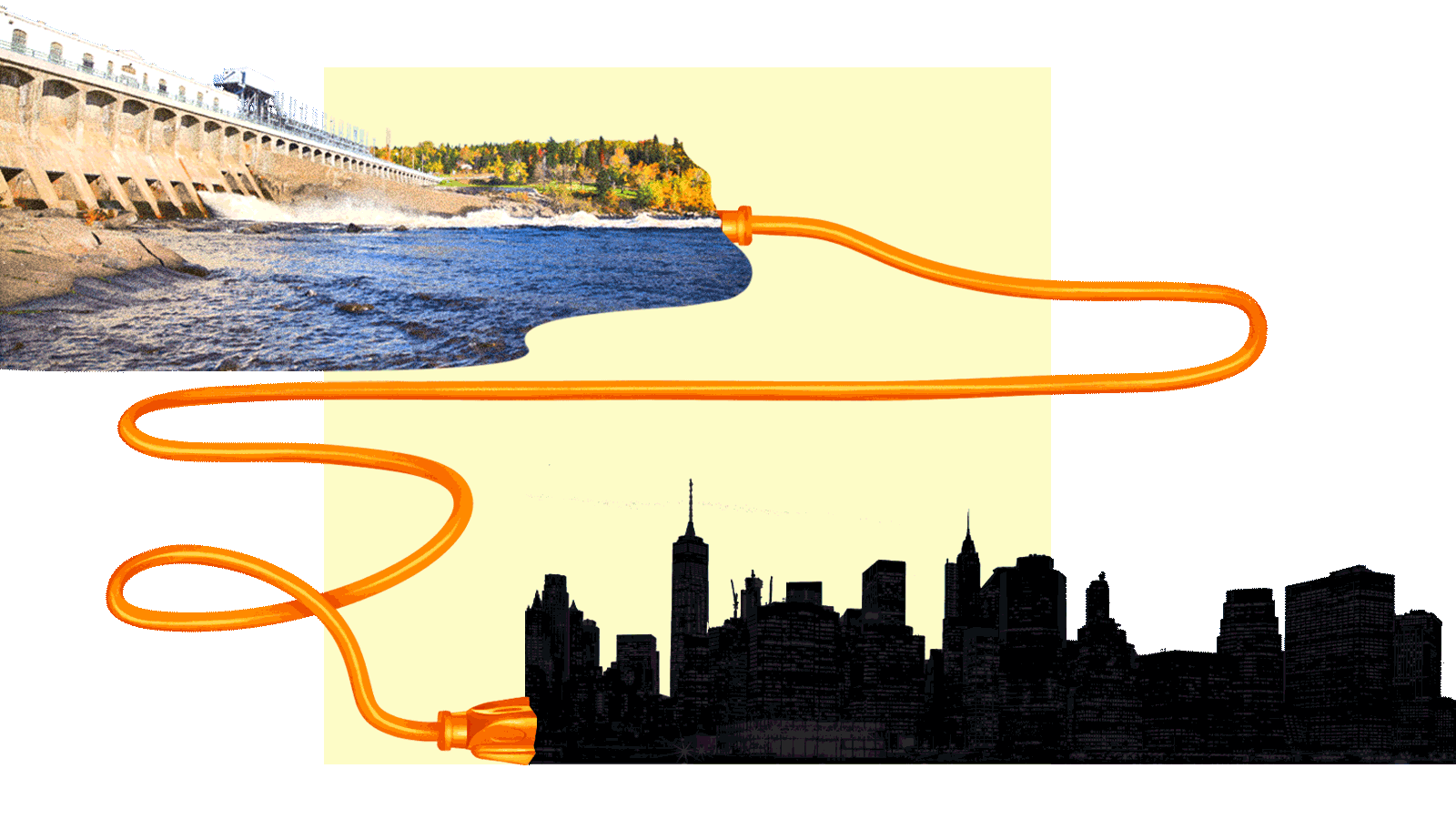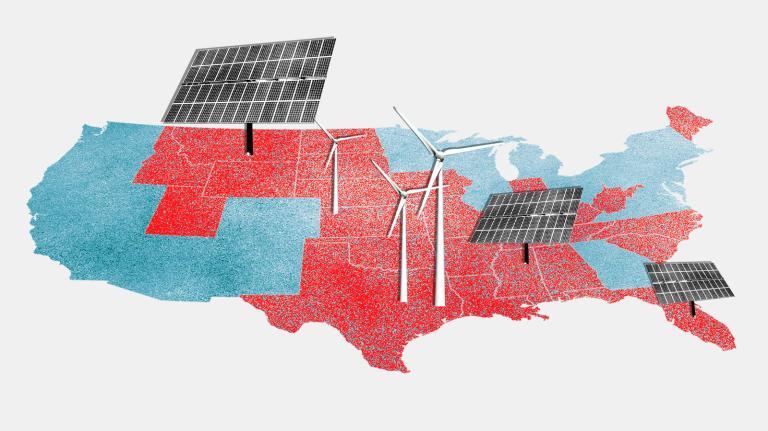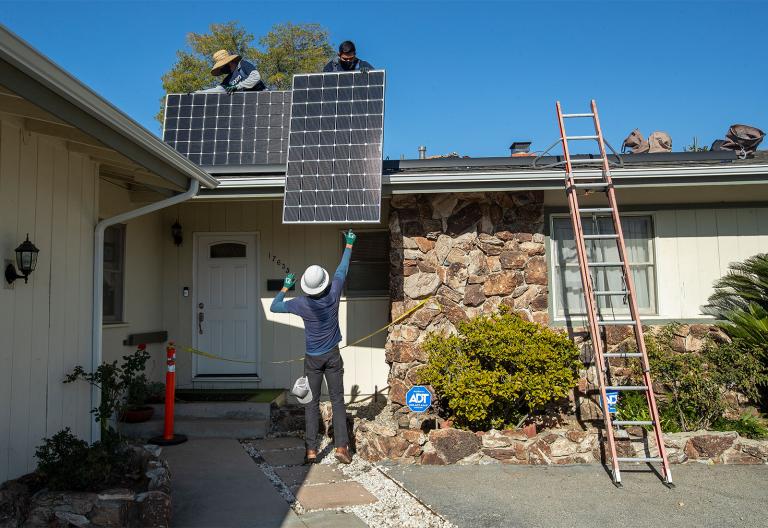New York has a mandate to transition to clean power. The state’s landmark 2019 Climate Leadership and Community Protection Act says the state must reach 100 percent zero-emissions electricity by 2040, but a major obstacle stands in the way: New York City’s grid. Some 85 percent of the Big Apple’s electricity comes from fossil fuels. By comparison, upstate New York runs on a grid that’s powered by 88 percent clean energy.
In mid-April, New York state regulators voted to approve two clean energy projects that are expected to reduce the city’s reliance on fossil fuels by more than 50 percent over the next 10 years. The first project, called Clean Path, will ship 1,300 megawatts of wind and solar from a northern New York county to NYC via a 175-mile underground transmission line starting in 2027. It has broad support from civil society groups across the state.
The second project, called the Champlain Hudson Power Express — or CHPE, pronounced “Chippy” — will do something similar: it will funnel clean energy into the city via a transmission line, part of which will be buried under the Hudson River. But the power CHPE will bring in isn’t local — it’s sourced from Canada, where dams owned by a company called Hydro-Québec generate a bounty of electricity. To meet its climate goals, the city has approved the construction of a 339-mile power cable carrying that excess hydropower from Québec all the way to Queens. This project, however, has faced stiff opposition from environmentalists and community groups, who argue that it outsources clean energy and jobs to a different country; from First Nations in Canada, who allege the company’s dams perpetrate environmental harms on Indigenous communities in Québec; and from critics who say hydropower isn’t as clean as its proponents claim.
Those groups did not succeed in stopping CHPE. The April vote by New York regulators was the last hurdle standing in its way. And from an emissions perspective, that appears to be a good thing: New York City will get 1,250 megawatts of clean power from Canada starting in 2025. That electricity, plus the power from the Clean Path line, are expected to supply more than a third of the city’s annual electricity consumption. The hydro will also do what wind and solar generated in the state can’t: provide a source of reliable power that keeps energy flowing into the city when the sun isn’t shining and the wind isn’t blowing.

But the way CHPE divided communities in New York, and the plan’s impact on First Nations in Canada, are worth paying attention to. Many states across the U.S. are embarking on a clean energy transition that should have begun decades ago. Now, up against hard deadlines and intensifying pressure to decarbonize their grids, states are being forced to make tough choices.
“This is the stuff that keeps me up at night,” Tracy Brown, president of the clean water advocacy group Riverkeeper, one of the environmental organizations that opposed CHPE, told Grist. “We’ve gotten to a point where there’s really no great alternatives left. We’ve waited so long that everything is going to involve a tradeoff.”
For decades, New York City had a powerful source of reliable low-carbon energy: the Indian Point nuclear power plant. After 59 years of operation, the plant’s last reactor was shuttered last year thanks to a dogged campaign waged against the reactors by environmentalists, who said the aging plant had become unsafe and was killing billions of fish and harming other aquatic wildlife as it siphoned water from the Hudson River to cool its reactors. Some 25 percent of the power keeping the lights on in New York City and the Hudson Valley winked off the grid just as the state was ramping up its efforts to reduce emissions.
Wind and solar couldn’t fill the void left by Indian Point for two reasons: Wind and solar are intermittent sources of energy that don’t provide the same kind of reliable, 24/7 power that nuclear provides. More importantly, the city has a transmission problem. There’s no way to get green power from the cleaner grid in upstate New York down to the city efficiently. Three natural gas-fired power plants came online between 2019 and 2021 to help New York City make up the slack as Indian Point’s reactors wound down. But regulators hoped they would be a short-term fix.
In January 2021, several months before Indian Point closed for good, the New York State Energy Research and Development Authority, or NYSERDA, put out a call for renewable energy projects. Hydropower projects, NYSERDA said, would be eligible if they were “existing or already under construction” by 2020. It received seven proposals from developers, CHPE and Clean Path among them.
For the city, CHPE looked like a neat solution to its transmission problem. It also fit NYSERDA’s requirements: Hydro-Québec completed its first dam in 1917. Construction on its latest hydroelectric project, which company officials say will be its last, started in 2009. In all, the company operates 61 hydroelectric generating stations that have been supplying Québec with clean power for decades. New York regulators liked the idea of plugging New York City’s grid into all of that existing clean power via a giant extension cord, and they ultimately approved both CHPE and Clean Path last month.
CHPE won’t just alleviate some of the city’s reliance on fossil fuels, it will help eliminate key sources of air pollution in some of New York City’s poorer neighborhoods. The city currently houses 19 antiquated and polluting “peaker” power plants, which run on natural gas, and sometimes kerosene, and get switched on during periods of peak energy demand. People in areas around those plants suffer from high rates of asthma and endure other negative health effects due to peaker plant pollution. “Low-income and communities of color are literally gasping to breathe,” Adrienne Esposito, executive director at the nonprofit Citizens Campaign for the Environment, a group that opposed Indian Point and supports CHPE, told Grist. A spokesperson for NYSERDA told Grist that CHPE will “substantially aid and accelerate the current efforts of peaker plant owners to explore the conversion of their facilities into energy storage and other clean energy technologies,” though the agency didn’t say how many of the 19 peaker plants will be offset by CHPE.

“These projects help bridge past that transmission bottleneck and help us use this in city fossil fuel generation half as much,” Daniel Zarrilli, former Chief Climate Policy Advisor to New York City Mayor Bill de Blasio and a special advisor on climate at Columbia University, told Grist. “It’s a huge impact.” But others don’t think that plugging into Québec’s excess hydro is the best idea.
Brown, the president of Riverkeeper, said the narrative around the CHPE has become “it’s either hydro from Canada or natural gas,” but she maintains that any of the other projects the city was considering, all of which focused on expanding wind or solar energy within the state, would have been better. “Our main thing is just we think there were better choices, better options,” she said.
Stephen Eisenman, cofounder of the community group the Anthropocene Alliance, also opposes the project on the grounds that it outsources economic opportunities and revenue to Canada. “If there’s profits to be made they ought to be made by New York State,” he said. He also took issue with the fact that the company that’s building the transmission line from Canada to New York City is owned by Blackstone, a massive investment group.
There are environmental justice concerns on the other end of the project, too. Several First Nations oppose CHPE, citing Hydro-Québec’s long history of flouting their rights and concerns.
Some of Hydro-Québec’s dams flooded First Nations lands in Québec that were never ceded to the Canadian government, impacting terrestrial and aquatic wildlife that the tribes depend on for food and traditional practices. Naturally occurring mercury in the soil of land that got flooded turned into methylmercury when it came into contact with bacteria in the water. Methylmercury is a potent neurotoxin that accumulates in fish and other aquatic organisms and can make its way up the food chain into humans. “The mercury is always there, it’s always present in the water and the fish,” Lucien Wabanonik, a Lac Simon Anishinaabe Nation councilor in Québec, told Grist.
Wabanonik wonders why Hydro-Québec would sell off its hydropower to the highest bidder when First Nation communities in Québec still lack power. One community, Kitcisakik, lives beside one of Hydro-Québec’s dams but doesn’t have access to the electricity that comes from it. “They only have generators, and they put gas in there to have light,” Wabanonik said. “To warm them up in their cabins they have to cut wood.”
In 2020, the Innu Nation of Labrador, another Indigenous community that opposes the project, partnered with the Center for Biological Diversity to send a formal notice of opposition to the U.S. Department of Energy calling on the agency to do a more thorough assessment of CHPE’s environmental impact. The impacts of Hydro-Québec’s dams on Indigenous communities, the letter says, “have historically been ignored.”
Wabanonik said Hydro-Québec should compensate tribes in the area for the harms they’ve experienced as a result of the company’s dams. “We have to live with these conditions,” he said. “They say this is for all of society, everyone benefits from it. Well, I don’t think First Nation people are really benefiting from it.”
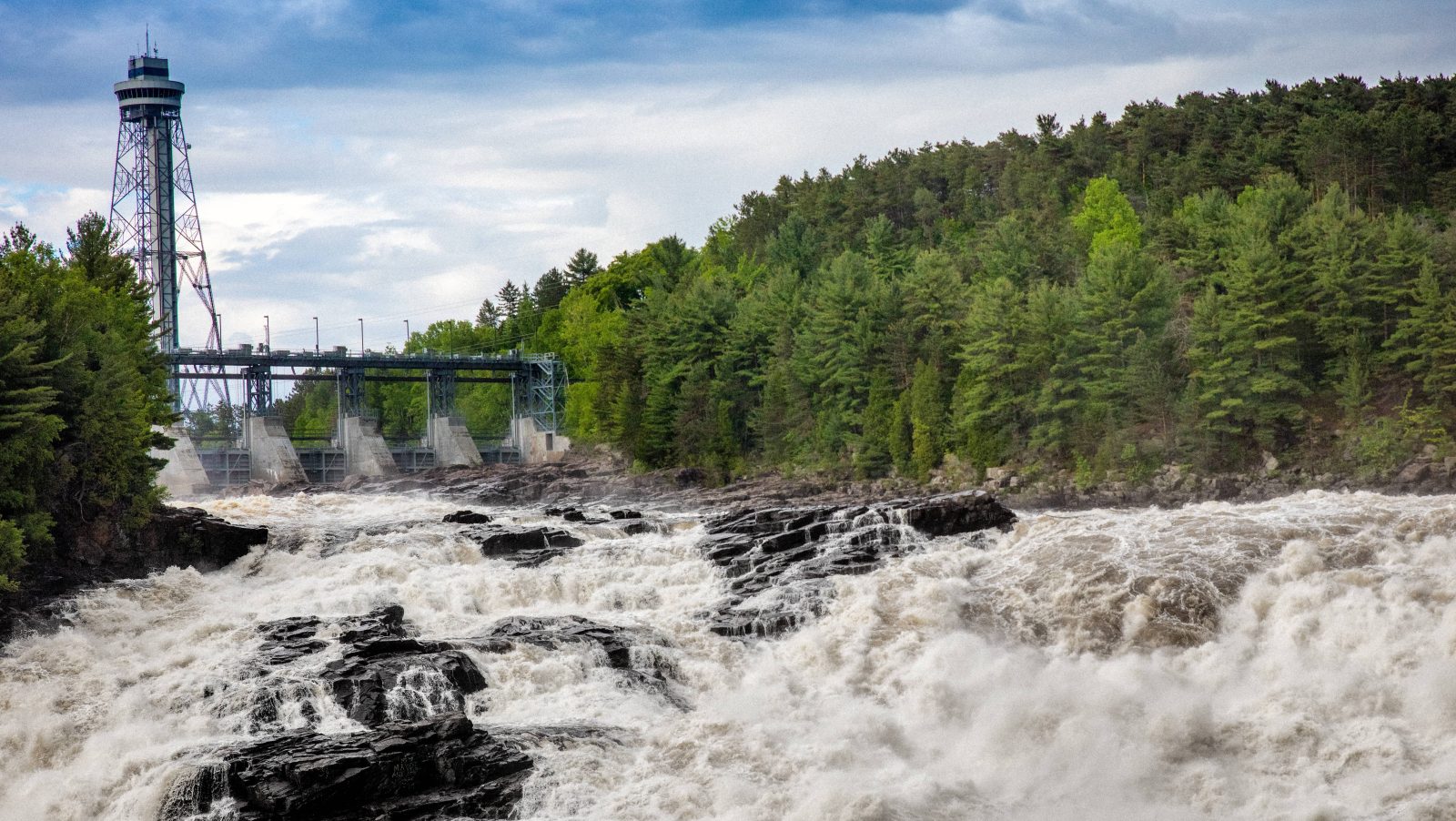
However, last month, the Mohawk Council of Kahnawà:ke, representing Mohawk communities in southeastern Canada and northern New York, released a statement blasting critics of the project and arguing that Hydro-Québec did its “due diligence in consulting with Indigenous groups.” The council acknowledged Hydro-Québec’s historical impacts on Indigenous communities but pointed out that no new power infrastructure will be built for CHPE. The council said it “has been a strong supporter of the CHPE and its construction, as it will significantly reduce the use of fossil fuel power plants” in the region.
Activists who tried to stop CHPE’s approval often touted a shocking statistic: some hydropower projects produce as many greenhouse gas emissions as coal-fired power plants. “There’s no clear evidence that CHPE will do anything to lower greenhouse gases,” Eisenman, cofounder of the Anthropocene Alliance, said.
It’s true that hydropower can produce significant amounts of carbon dioxide and methane emissions. That’s because flooding a wooded area to create a reservoir prevents the area from absorbing carbon dioxide, turning it from a carbon sink into a carbon source as the submerged vegetation decomposes. In tropical regions, these emissions can indeed rival the emissions produced by coal-fired plants. Some reservoirs continue to produce emissions long after the original organic matter that once grew there has decomposed because of algae or agricultural runoff. Others produce emissions for a number of years and then stop becoming a significant source of methane and CO2.
It’s not true, however, that Hydro-Québec’s existing dams — the ones that will be sending excess power to NYC once CHPE is built — are major sources of emissions. Most studies, including some funded by Hydro-Québec, indicate that the company’s reservoirs produce far fewer emissions than natural gas or other fossil fuels. An independent 2021 study showed that the electricity produced in Québec, 95 percent of which comes from hydropower, emits just 35 grams of emissions per kilowatt-hour. Natural gas, by comparison, produces between 400 and 600 grams per kilowatt-hour. Coal produces between 900 and 1,000.
“What we’ve seen in Québec, and a lot of measurements have been done, is that emissions are not so high,” Annie Levasseur, a professor of environmental engineering at the University of Québec and the lead author of the 2021 study, told Grist. Levasseur found that emissions in Québec spiked in the first 10 years after a reservoir was created, but those emissions, she said, “are still much much lower than, for instance, producing electricity from natural gas or coal.”
The general consensus among academics and researchers is that hydropower is a crucial aspect of the transition to clean energy. It’s not just that hydropower tends to be a low-carbon alternative to natural gas; it’s also that it’s flexible. It can fill in the gaps left by greener but more intermittent technologies like wind and solar.
Some of the activist groups that worked to close the Indian Point nuclear point plant think that’s reason enough to support CHPE. These groups have thrown their support behind the transmission line not because they think it’s a perfect plan, one community organizer told Grist, but because they recognize the urgency of the climate threat and because few other options exist at this point. Any ratcheting down of emissions that occurs in the short term, such as the one that will take place when CHPE comes online and NYC’s peaker plants shut down, will alleviate some degree of warming, and the suffering that comes with it, in the future.
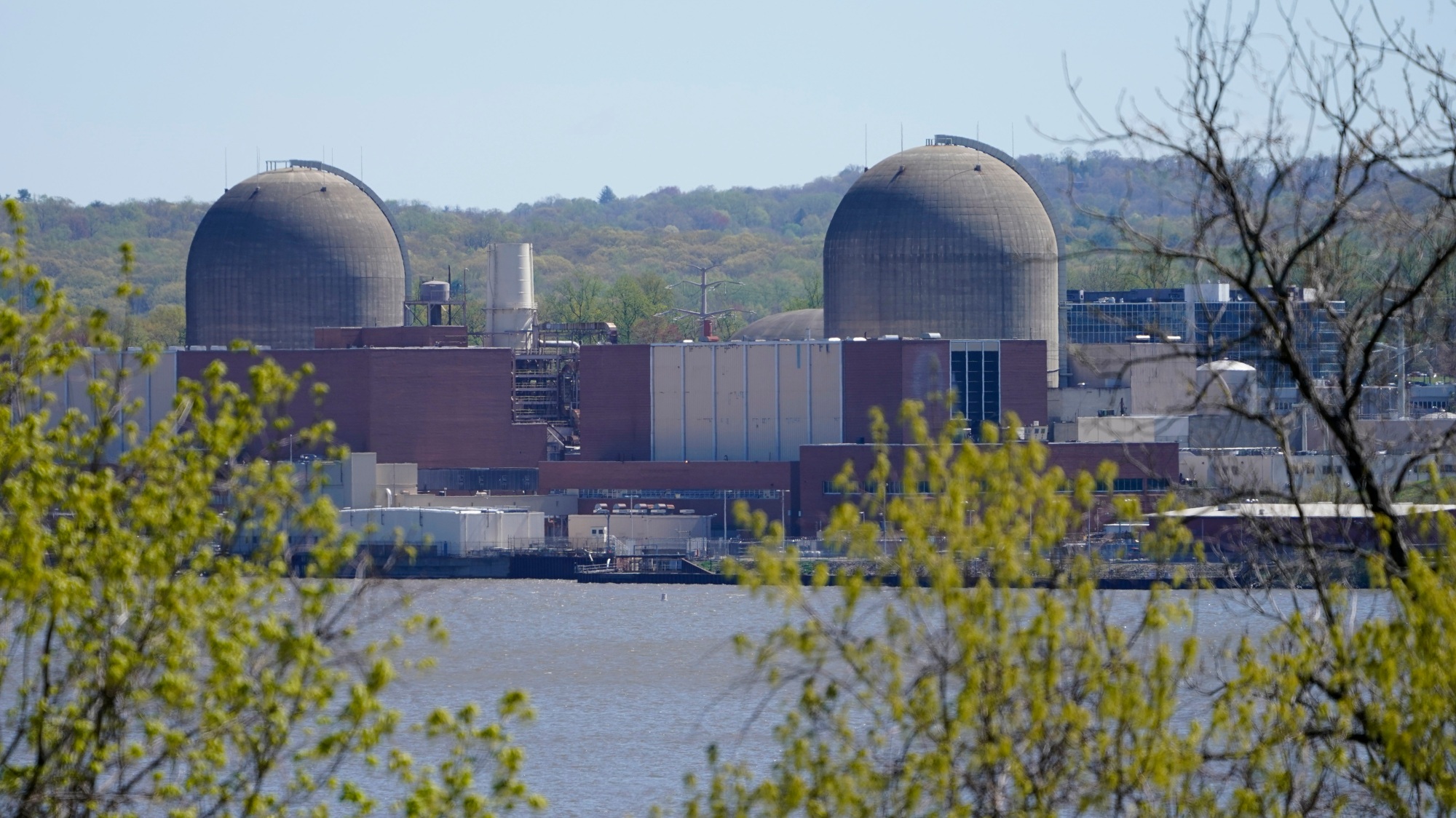
“We can’t be whimsical about what kind of power should go to New York City,” Esposito, the director of the Citizens Campaign for the Environment, said. “Saying no to the clean hydro is saying yes to continuing on with fossil fuels and the antiquated power plants. It’s our ethical obligation to choose the infrastructure project with the least impact.”
But CHPE’s opponents argue that the ethics of the transmission line aren’t so clear cut. Powering down polluting peaker plants in New York City solves an environmental justice problem in Queens, but what happens to Indigenous communities in Québec who have their own issues with Hydro-Québec’s reservoirs? The company has said it won’t build any new dams, but hydropower is proving to be a valuable and in-demand commodity. Brown, the Riverkeeper president, doesn’t trust that Hydro-Québec will stick to its promise not to build any new dams. “Of course, if they’re opening new markets in the U.S., it’s going to trigger dam building,” she said. Whether or not Brown’s prediction comes true, First Nations in Québec maintain that the existing dams have been taking a toll on their way of life and will continue to do so. That’s an impact energy consumers in New York City won’t see or feel.
Weighing these kinds of tradeoffs will be the name of the game in coming years, as states scramble to make the belated transition from fossil fuels to clean energy. Community opposition to large-scale clean energy projects across the country shows how complicated that transition already is and will continue to be. Activists oppose an 800-megawatt offshore wind project off New England on the grounds that it will harm whales. Communities near Las Vegas oppose the now-approved $1 billion Gemini solar and battery storage project because it’s too big. Last year, voters in Maine approved a measure that temporarily stopped a project similar to CHPE after environmental groups, conservationists, and tribes in Maine and Canada waged a campaign against it. That project, if completed, will channel hydropower from Québec into Maine via a 145-mile transmission corridor. The legal fight that followed the vote in Maine made it all the way to the state’s Supreme Court this week.
“CHPE is just one of many projects that are going to be complicated and difficult but necessary in order to meet the goals of the Paris Agreement,” Zarrilli, the former New York City climate advisor, said. “These are the kinds of choices we’re going to be faced with quite often going forward. We’re going to need to be able to make hard choices.”

